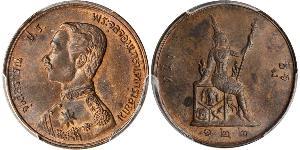(Venduta per $465.0)
1287, Crusader States, County of Tripoli, Bohemond IV. Gold Saracen Bezant Coin. 3.4gm!
Mint Place: Acre Mint Period: 1143-1163 AD Ruler: Baldwin III (1143-1163 AD) Reference: Friedberg 1 (listed under Jerusalem), Malloy 4a, Metcalf 487. Very Rare! Condition: Well-struck on a slightly irregular planchet with a mint-made split, otherwise a beautiful XF-AU! Denomination: Saracenic Bezant - Struck by the Crusaders state of Tripoli (County of Tripoli) under Bohemond IV in imitation of a Fatimid Dinars of al Mustansir (1036-1094)! Diameter: 23mm Weight: 3.40gm Material: Gold!
Obverse: Pseudo Kufic stylized script in three lines above two pellets. Two bands of legends around. Three dots (privy mark) around central maedallion!
Reverse: Pseudo Kufic stylized script in three lines. Two bands of legends around. Three dots (privy mark) around central maedallion!
Until 1254, the Crusader Coinage was imitating Fatimid coinage and included all of their inscriptions, to match the currency standard, which was widely accepted. In 1254 the Pope´s ambassador Odo of Châteauroux accompanied Louis IX of France, returning from the Sixth Crusade, reported to the Pope, that Christians are striking coins with "the name of Muhammad and the number of years since his birth". Immediately after that report, the coinage inscriptions changed the designs to Christian legends, still written in Arabic legends and crosses instead of Fatimid ruler names.
Bezant is a medieval name for a gold coin. Gold coins were not minted in early medieval Western Europe, silver and bronze being the currency of choice, but they did circulate there in small numbers, originating from the Mediterranean region. Islamic and Byzantine gold coins, in particular, were highly prized. These gold coins were commonly called bezants, taken from the word Byzantium, the Latinized form of the original Greek name (Βυζάντιον or "Byzántion") of the capital, Constantinople, where the gold coins typically came from, and were associated with, since the time of Constantine I.
The first bezants were Byzantine solidi. Later, the term referred to gold dinars minted in the Islamic Caliphates that were themselves modelled on the solidus. Bezant was used by Venetians to refer to the Egyptian gold dinar and Marco Polo referred to the bezant in the account of his travels to East Asia.
The County of Tripoli (1109–1289) was the last of the Crusader states. It was founded in the Levant in the modern-day region of Tripoli, northern Lebanon and parts of western Syria which supported an indigenous population of Christians, Druze and Muslims. When the Christian Crusaders – mostly Frankish forces – captured the region in 1109, Bertrand of Toulouse became the first Count of Tripoli as a vassal of King Baldwin I of Jerusalem. From that time, the rule of the county was decided not strictly by inheritance but by factors such as military force (external and civil war), favour and negotiation. In 1289 the County of Tripoli fell to Sultan Qalawun of the Muslim Mamluks of Cairo. The county was absorbed into Mamluk Egypt.
Raymond IV of Toulouse was one of the wealthiest and most powerful of the Prince Crusaders. Even so, after the First Crusade, he had failed to secure any land holdings in the Near East. Meanwhile, the County of Edessa, the Kingdom of Jerusalem and the Principality of Antioch had been established. Tripoli was an important strategic goal as it linked the French in the south with the Normans in the north. It was a fertile and well populated area. In 1102, Raymond IV occupied Tortosa (now Tartus) and in 1103, he prepared, together with veterans of the 1101 crusade, to take Tripoli.
On a natural ridge, which he named "Mons Peregrinus" (French: Mont Pèlerin, English: Mount Pilgrim), 3 kilometres (1.9 mi) from Tripoli, Raymond IV (also known as Raymond de Saint-Gilles) began the construction of a large castle, known in Arabic as Qal'at Sanjil. Despite this new fortress and seasoned troops, Raymond IV's siege of Tripoli failed to secure the port. He died on 25 February 1105.
Count William of Cerdagne, Raymond IV's cousin and comrade, was supported by Tancred, Prince of Galilee, but his succession in the Tripoli campaign was challenged by Raymond IV's illegitimate son, Bertrand of Toulouse. Bertrand of Toulouse, who was supported by Baldwin I of Jerusalem, arrived in the Near East with a substantial army and a large Genoese fleet. In order to resolve the succession issue, Baldwin I created a partition treaty. It specified that William was to hold northern Tripoli and pay homage to Tancred while Bertrand was to hold south Tripoli as a vassal of Baldwin. mUnder a united Christian onslaught, Tripoli fell on 12 July 1109, completing the Kingdom of Jerusalem. When William died of an arrow through the heart (some claim it was murder), Bertrand became the first Count of Tripoli.
The extent of the County of Tripoli was determined in part by pre-existing Byzantine borders and in part by victory in battle, tempered by the demands of neighbouring crusader states. At its height, the county controlled the coastline from Maraclea in the north to Beirut in the south. Inland, the county's control extended to the Krac des Chevaliers fortress. The rich inland agricultural land of the Homs Gap was known as La Bocquée. The county was divided into 'lordships'; areas based roughly around its coastal ports. The Count of Tripoli himself held the port of Tripoli and its surrounds. He also controlled the hostile region of Montferrand, now modern-day Bar'in, Syria, lying to the east. Approximately one quarter of the land seized around Tripoli was given to the Genoese as payment for military aid. The Genoese admiral Guglielmo Embriaco was awarded the city of Jubail.
Despite his contribution to its establishment, Baldwin I did not directly control the County of Tripoli. Nevertheless, the County of Tripoli owed fealty (allegiance) and homage (declarations of allegiance) to him, and he, in return, provided support to the county in times of trouble.
Although occupying a narrow coastal plain, the mountain range beyond was a natural defensive line for Tripoli. Several castle forts were built to defend the mountain passes. Muslim forces (Turk and Egyptian) attacked the County of Tripoli along its borders, especially those to the east. (p73) In 1137, Raymond II, the reigning count, lost control of Montferrand. The Muslim position strengthened when the Hashshashin (Nazari Ismailis) forces formed in the Nosairi mountains to the north. In 1144, in order to increase the county's defences, particularly against Zangi of Mosul, Raymond II gave the Knights Hospitaller large stretches of frontier land along the Buqai'ah plain. This included the castles of Krak des Chevaliers, Anaz, Tell Kalakh, Qalaat el Felis and Mardabech. (p30) In the 1150s, the defences were further strengthened by the presence of the Knights Templar at Tartus on the seashore.
Bohemond IV of Antioch, also known as Bohemond the One-Eyed (French: Bohémond le Borgne; c. 1175–1233), was Count of Tripoli from 1187 to 1233, and Prince of Antiochfrom 1201 to 1216 and from 1219 to 1233. He was the younger son of Bohemond III of Antioch. The dying Raymond III of Tripoli offered his county to Bohemond's elder brother, Raymond, but their father sent Bohemond to Tripoli in late 1187. Saladin, the Ayyubidsultan of Egypt and Syria, conquered the county, save for the capital and two fortresses, in summer 1188.
Raymond died in early 1197, leaving a posthumous son, Raymond-Roupen. Raymond-Roupen's mother, Alice, was the niece of Leo I of Cilicia who persuaded the Antiochene noblemen to acknowledge Raymond-Roupen's right to succeed his grandfather. However, the Latin and Greek burghers proclaimed Bohemond heir to his father. After his father died in April 1201, Bohemond seized Antioch with the support of the burghers, the Knights Templar and Hospitallers, and the Italian merchants.
Bohemond made an alliance with Az-Zahir Ghazi, the Ayyubid emir of Aleppo, and Kaykaus I, the Seljuq sultan of Rum, who often invaded Cilicia during the following years, to prevent Leo I from attacking Antioch. Conflicts between Bohemond and the Latin Patriarchs of Antioch enabled Raymond-Roupen to seize Antioch in 1216, but Bohemond regained the principality in 1219. After Leo I's death, Bohemond tried to secure Cilicia to his younger son, Philip, but Constantine of Baberon, who had administered Cilicia during the previous years, imprisoned Philip in 1224. Bohemond allied with Kayqubad I, sultan of Rum, but he could not prevent Philip's murder in 1225.
Only 1$ shipping for each additional item purchased!
27 coin descriptions were improved from 2015-05-24 to 2015-05-27
Una di queste è:
1 Att Thailandia Bronzo
il gruppo ha 12 monete / 12 prezzi














